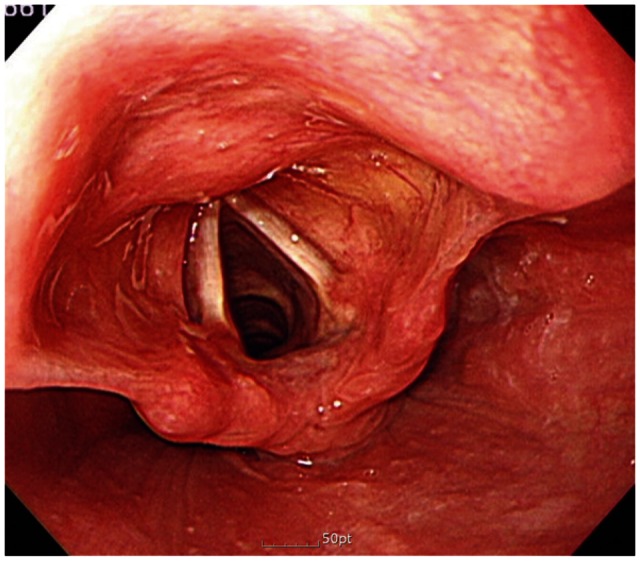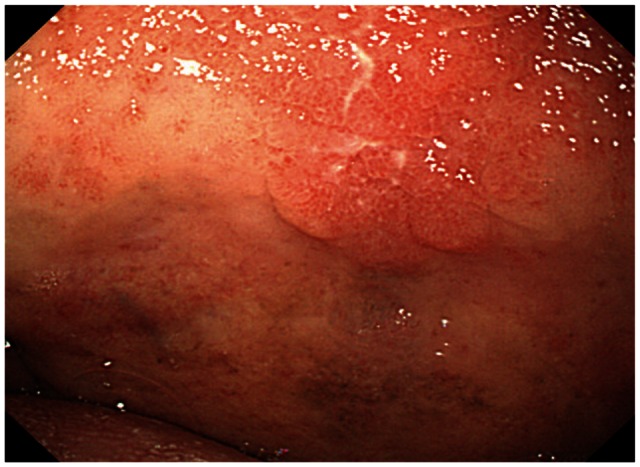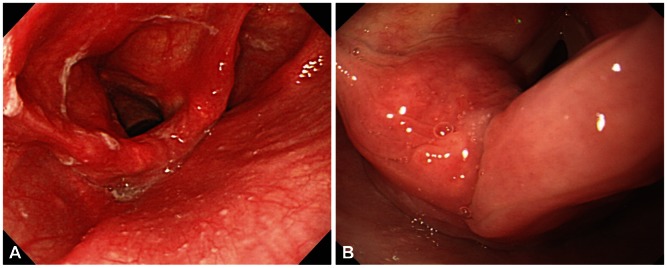Clin Endosc.
2013 May;46(3):224-229. 10.5946/ce.2013.46.3.224.
Observable Laryngopharyngeal Lesions during the Upper Gastrointestinal Endoscopy
- Affiliations
-
- 1Department of Internal Medicine, Keimyung University School of Medicine, Daegu, Korea. seenae99@dsmc.or.kr
- KMID: 2048924
- DOI: http://doi.org/10.5946/ce.2013.46.3.224
Abstract
- Regardless of outstanding developments in the endoscopic field, laryngopharyngeal lesions are generally considered as a field of otolaryngology, and thus it is thought that not a lot of gastrointestinal endoscopists commonly take interest in these lesions during the upper gastrointestinal endoscopic examinations. Therefore, here in this thesis, I reviewed the availability of upper gastrointestinal endoscopy in laryngopharyngeal area, normal structures of laryngopharynx, and the lesions that can be observed with the standard upper gastrointestinal endoscopic procedure.
Keyword
Figure
Cited by 1 articles
-
Highlights of the 48th Seminar of Korean Society of Gastrointestinal Endoscopy
Kwang An Kwon, Il Ju Choi, Eun Young Kim, Seok Ho Dong, Ki Baik Hahm
Clin Endosc. 2013;46(3):203-211. doi: 10.5946/ce.2013.46.3.203.
Reference
-
1. Chang DK. Current status of colorectal endoscopic submucosal dissection in Korea. Clin Endosc. 2012; 45:288–289. PMID: 22977820.
Article2. Goh PG, Jeong HY, Kim MJ, et al. Clinical outcomes of endoscopic submucosal dissection for undifferentiated or submucosal invasive early gastric cancer. Clin Endosc. 2011; 44:116–122. PMID: 22741122.
Article3. Kim YS, Cho WY, Cho JY, Jin SY. Successful treatment of early gastric cancer adjacent to a fundal varix by endoscopic submucosal dissection and endoscopic cyanoacrylate therapy. Clin Endosc. 2012; 45:169–173. PMID: 22866260.
Article4. Katsinelos P, Kountouras J, Chatzimavroudis G, et al. Should inspection of the laryngopharyngeal area be part of routine upper gastrointestinal endoscopy? A prospective study. Dig Liver Dis. 2009; 41:283–288. PMID: 18701359.
Article5. Cammarota G, Galli J, Agostino S, et al. Accuracy of laryngeal examination during upper gastrointestinal endoscopy for premalignancy screening: prospective study in patients with and without reflux symptoms. Endoscopy. 2006; 38:376–381. PMID: 16680637.
Article6. Raju GS. Value of screening the laryngopharyngeal area during routine upper gastrointestinal endoscopy. Nat Clin Pract Gastroenterol Hepatol. 2005; 2:22–23. PMID: 16265096.
Article7. Mullhaupt B, Jenny D, Albert S, Schmid S, Fried M. Controlled prospective evaluation of the diagnostic yield of a laryngopharyngeal screening examination during upper gastrointestinal endoscopy. Gut. 2004; 53:1232–1234. PMID: 15306576.
Article8. Yarze JC, Chase MP, Herlihy KJ. Laryngopharyngeal examination: an important but not-so-new role of upper gastrointestinal endoscopy. Ann Intern Med. 2000; 133:314–315. PMID: 10929187.
Article9. Kozarek RA. Evaluation of the larynx, hypopharynx, and nasopharynx at the time of diagnostic upper gastrointestinal endoscopy. Gastrointest Endosc. 1985; 31:271–273. PMID: 4029577.
Article10. Lehman G, Compton M, Meadows J, Elmore M. Screening examination of the larynx and pharynx during upper gastrointestinal panendoscopy. Gastrointest Endosc. 1982; 28:176–178. PMID: 7129039.
Article11. Choi JH, Park JJ, Jee JB, et al. Endoscopic treatment of benign hypopharyngeal tumors. Korean J Gastrointest Endosc. 2005; 31:306–310.12. Matsuo K, Palmer JB. Anatomy and physiology of feeding and swallowing: normal and abnormal. Phys Med Rehabil Clin N Am. 2008; 19:691–707. PMID: 18940636.
Article13. Vakil N, van Zanten SV, Kahrilas P, Dent J, Jones R. Global Consensus Group. The Montreal definition and classification of gastroesophageal reflux disease: a global evidence-based consensus. Am J Gastroenterol. 2006; 101:1900–1920. PMID: 16928254.
Article14. Ford CN. Evaluation and management of laryngopharyngeal reflux. JAMA. 2005; 294:1534–1540. PMID: 16189367.
Article15. Koufman JA. The otolaryngologic manifestations of gastroesophageal reflux disease (GERD): a clinical investigation of 225 patients using ambulatory 24-hour pH monitoring and an experimental investigation of the role of acid and pepsin in the development of laryngeal injury. Laryngoscope. 1991; 101(4 Pt 2):Suppl 53. 1–78. PMID: 1895864.16. Hickson C, Simpson CB, Falcon R. Laryngeal pseudosulcus as a predictor of laryngopharyngeal reflux. Laryngoscope. 2001; 111:1742–1745. PMID: 11801937.
Article17. Qadeer MA, Swoger J, Milstein C, et al. Correlation between symptoms and laryngeal signs in laryngopharyngeal reflux. Laryngoscope. 2005; 115:1947–1952. PMID: 16319603.
Article18. Hicks DM, Ours TM, Abelson TI, Vaezi MF, Richter JE. The prevalence of hypopharynx findings associated with gastroesophageal reflux in normal volunteers. J Voice. 2002; 16:564–579. PMID: 12512644.
Article19. Branski RC, Bhattacharyya N, Shapiro J. The reliability of the assessment of endoscopic laryngeal findings associated with laryngopharyngeal reflux disease. Laryngoscope. 2002; 112:1019–1024. PMID: 12160267.
Article20. Merati AL, Lim HJ, Ulualp SO, Toohill RJ. Meta-analysis of upper probe measurements in normal subjects and patients with laryngopharyngeal reflux. Ann Otol Rhinol Laryngol. 2005; 114:177–182. PMID: 15825565.
Article21. Noordzij JP, Khidr A, Desper E, Meek RB, Reibel JF, Levine PA. Correlation of pH probe-measured laryngopharyngeal reflux with symptoms and signs of reflux laryngitis. Laryngoscope. 2002; 112:2192–2195. PMID: 12461340.
Article22. Belafsky PC, Postma GN, Koufman JA. The validity and reliability of the reflux finding score (RFS). Laryngoscope. 2001; 111:1313–1317. PMID: 11568561.
Article23. Lien HC, Wang CC, Hsu JY, et al. Classical reflux symptoms, hiatus hernia and overweight independently predict pharyngeal acid exposure in patients with suspected reflux laryngitis. Aliment Pharmacol Ther. 2011; 33:89–98. PMID: 21083591.
Article24. Reichel O, Dressel H, Wiederänders K, Issing WJ. Double-blind, placebo-controlled trial with esomeprazole for symptoms and signs associated with laryngopharyngeal reflux. Otolaryngol Head Neck Surg. 2008; 139:414–420. PMID: 18722223.
Article25. Belafsky PC, Postma GN, Koufman JA. Laryngopharyngeal reflux symptoms improve before changes in physical findings. Laryngoscope. 2001; 111:979–981. PMID: 11404607.
Article26. Scott JC, Jones B, Eisele DW, Ravich WJ. Caustic ingestion injuries of the upper aerodigestive tract. Laryngoscope. 1992; 102:1–8. PMID: 1731151.
Article27. Giannini PJ, Shetty KV. Diagnosis and management of oral candidiasis. Otolaryngol Clin North Am. 2011; 44:231–240. PMID: 21093632.
Article28. Chu EA, Kim YJ. Laryngeal cancer: diagnosis and preoperative work-up. Otolaryngol Clin North Am. 2008; 41:673–695. PMID: 18570953.
Article29. Kim JH, Park JE, Nam JH, et al. A case of synchronous esophageal basaloid squamous carcinoma and cancer of the base of tongue. Korean J Gastrointest Endosc. 2005; 31:383–386.30. Chung KW, Sun HS, Park DH, et al. A case of esophageal cancer with metastasis to the pharynx. Korean J Gastrointest Endosc. 1996; 16:63–67.31. Yoshimura N, Goda K, Tajiri H, et al. Diagnostic utility of narrow-band imaging endoscopy for pharyngeal superficial carcinoma. World J Gastroenterol. 2011; 17:4999–5006. PMID: 22174550.
Article32. Tanaka S, Morita Y, Fujita T, et al. Clinicopathological characteristics of abnormal micro-lesions at the oro-hypopharynx detected by a magnifying narrow band imaging system. Dig Endosc. 2012; 24:100–109. PMID: 22348834.
Article33. Sue RD, Susanto I. Long-term complications of artificial airways. Clin Chest Med. 2003; 24:457–471. PMID: 14535220.
Article34. Jung SW. Two cases of vocal cord paralysis complicated by upper gastrointestinal endoscopy. Korean J Gastrointest Endosc. 2006; 33:32–36.
- Full Text Links
- Actions
-
Cited
- CITED
-
- Close
- Share
- Similar articles
-
- Introduction to Starting Upper Gastrointestinal Endoscopy: Proper Insertion, Complete Observation, and Appropriate Photographing
- Upper gastrointestinal diseases diagnosed by upper gastrointestinal fiberoptic endoscopy in children
- The Diagnosis of Subepithelial Lesions in the Upper Gastrointestinal Tract
- A Case of Successful Laser Photocoagulation in Gastric Telangiectasias
- Upper Endoscopy in International Digestive Endoscopy Network 2012: Towards Upper End of Quality




